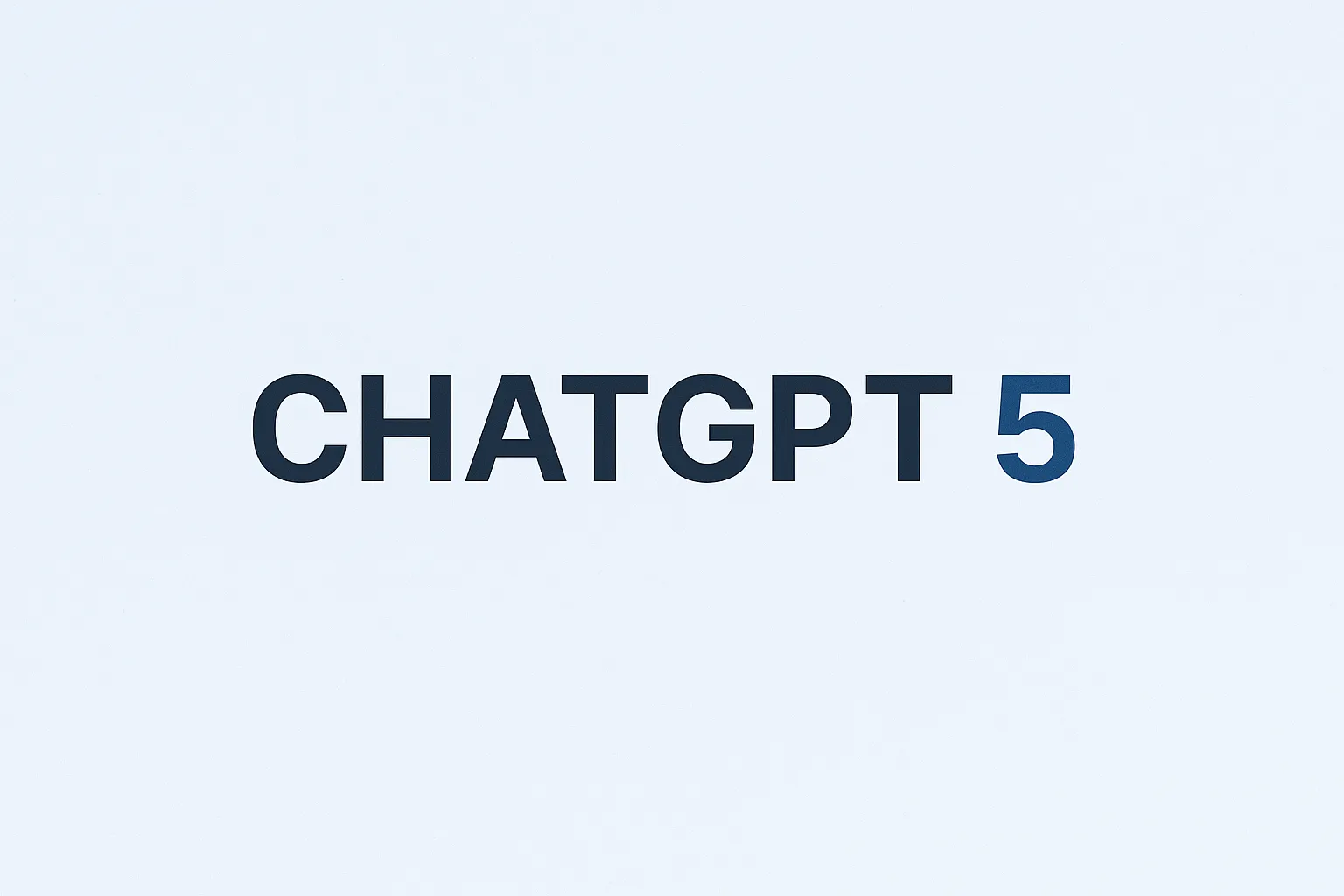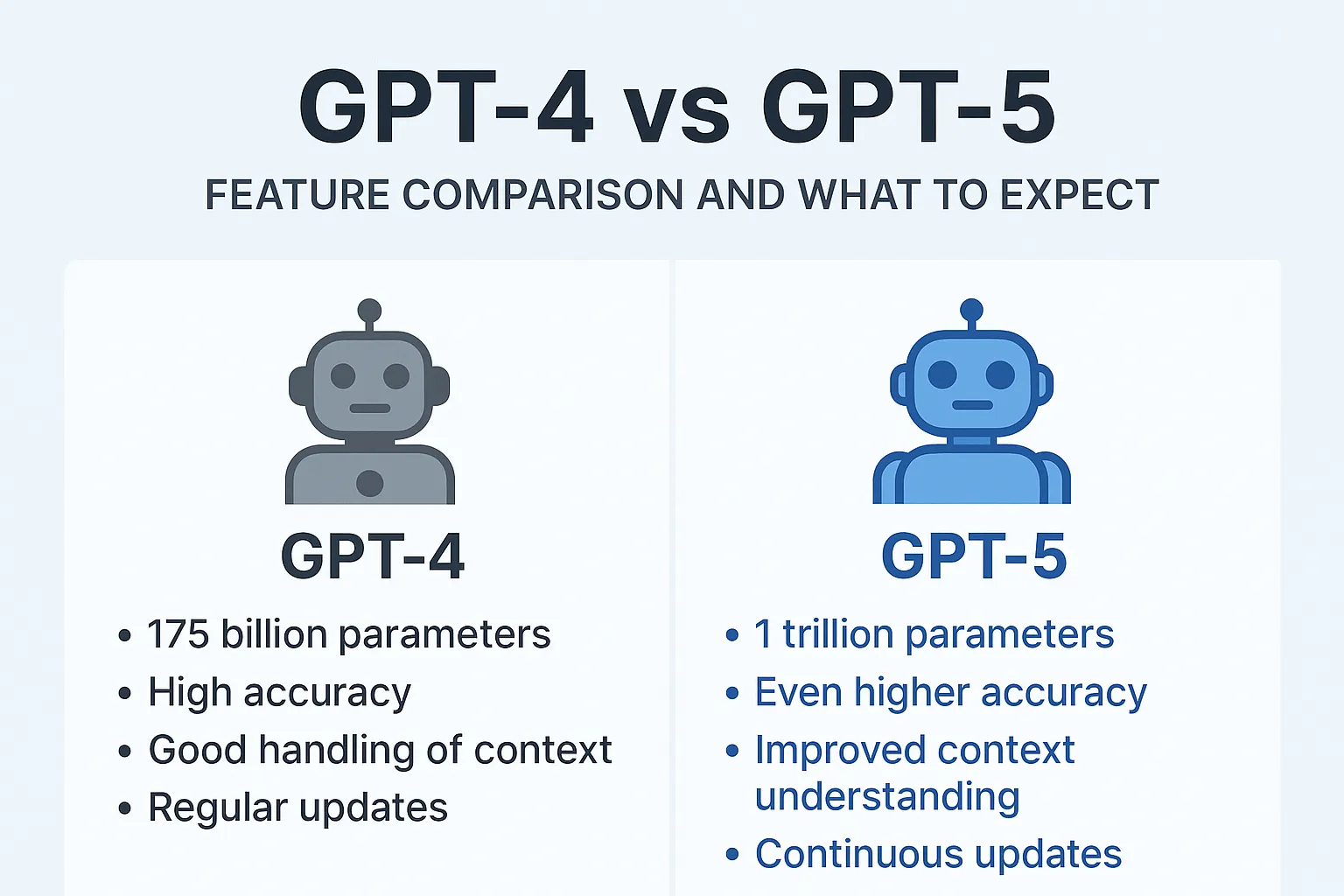ProjectsAboutBlogsContact
Software Development
Web Design and Development
Mobile Application
Cloud Solutions
Big Data Services
AI & ML Solutions
CRM Consulting
A remote software development company
The world of artificial intelligence is evolving at an unprecedented pace, with OpenAI leading the charge in developing sophisticated language models that are transforming industries, enhancing productivity, and unlocking new possibilities.

Among the most anticipated developments is ChatGPT 5, the next iteration of OpenAI’s powerful conversational AI. In this comprehensive guide, we will explore everything you need to know about ChatGPT 5, from its expected features and release timeline to its competitive benchmarks and pricing details.
ChatGPT 5 is projected to be OpenAI’s next major leap in generative AI. Building on GPT-4 (and GPT-4o), it’s not just an upgrade in power, but potentially a shift in how people interact with AI.
● Mainstream applications will become more seamless and human-like.
● Enterprise and developer tools will benefit from greater reliability, customizability, and safety.
● Educational and research sectors may use GPT-5 for more advanced tutoring and analysis.
This is the game-changer.
● Upload a photo of a broken machine, and GPT-5 could help diagnose the issue.
● Play a short video, and it could explain the physics or emotions behind it.
● Upload a graph, and it could summarize the key takeaways in plain English.
You might be able to speak to it (voice input), show it something (image), and receive back a text+image+voice response — like a true intelligent assistant.
GPT-5 will likely be optimized to:
● Run faster on your phone or browser.
● Give real-time responses (no lag during typing).
● Consume less memory or compute, making it greener and more scalable.
💡 Think: Siri or Alexa, but actually useful, insightful, and emotionally intelligent.
OpenAI is investing heavily in:
● Reducing hallucinations (false information).
● Filtering harmful or biased content.
● Transparent reasoning, where the AI can explain why it gave a response.
Governments and companies are demanding trustworthy AI. GPT-5 needs to be safe for education, health, finance, and law — industries with real risks.
You may be able to:
● Save memory of your preferences, tone, personality.
● Choose your own “AI assistant personality” (e.g. formal, casual, humorous).
● Developers could create industry-specific versions (for legal, medical, academic, etc.).
A doctor could set up GPT-5 to help generate patient-friendly medical explanations based on their clinic’s protocols.
GPT-5 is expected to better handle:
● Multi-step logic problems (like solving complex math or legal reasoning).
● Longer context retention, possibly handling over 100K+ tokens (text length).
● Code generation that’s cleaner and more maintainable.
Implication: You’ll get smarter, more context-aware responses — especially useful in research, coding, and professional writing.
GPT-4o already introduced some multimodal functionality. GPT-5 may extend this by:
● Accepting video inputs, making it possible to analyze footage (e.g., security, education).
● Understanding complex visual-text scenarios, like interpreting charts, graphs, or real-time image feedback.
Potential Applications:
● Virtual assistants that understand facial expressions.
● AI that can help with diagnosing visual medical data.
● Seamless integration with AR/VR tools.
GPT-5 may be optimized for:
● Real-time interaction, ideal for live support and streaming use cases.
● Edge AI deployment (AI running on-device without cloud connection).
Implication: Could work well in constrained environments (e.g., mobile apps, embedded systems).
OpenAI has faced pressure regarding misinformation, bias, and hallucinations. GPT-5 is expected to:
● Include built-in safeguards against harmful or false outputs.
● Use dynamic context filtering to better understand and flag risky content.
● Business value: Greater trust in using AI in regulated industries (healthcare, finance, etc.).
There may be:
● User-defined personalities or assistant styles.
● Memory features that tailor responses based on past interactions.
● Developer controls for domain-specific tuning (e.g., legal, scientific, HR bots).
Implication: Personal AI becomes more truly personal and adaptable.
Likely trained on datasets up to early or mid-2025, giving it a fresher perspective than GPT-4.
● More up-to-date on emerging tech, events, language trends, etc.
● Better grasp of current APIs, tools, regulations, and cultural shifts.

● Official Announcement: Possibly at NeurIPS 2025 or CES 2025.
● Release Date: Likely late 2025 or early 2026.
Why the delay?
● OpenAI likely wants to improve safety, reliability, and performance across multiple modalities.
● External scrutiny (from governments and the public) may delay rollout to ensure responsible deployment.
Once GPT-5 is live, users will probably have access through:
● chat.openai.com or via the ChatGPT iOS/Android apps.
● Possibly integrated into Microsoft Copilot (Word, Excel, Teams) and other partner apps.
● Via OpenAI’s developer platform or Azure OpenAI Service.
● Used for building advanced assistants, analysis tools, or autonomous agents.
● Likely available via a Pro or Enterprise subscription.
● May include priority access, longer context, and exclusive features.
● Free Tier: Limited speed/capability, similar to current GPT-3.5 offerings.
● ChatGPT Plus/Pro: Monthly fee (~$20–$50, possibly more if multimodal power is enhanced).
● Enterprise: Scalable plans for businesses, possibly with data control and API priority.
Expected to outperform in:
● MMLU (Massive Multitask Language Understanding)
● CodeX and HumanEval for programming tasks
● Long-context benchmarks (e.g., Book QA, Needle-in-a-Haystack)
● GPT-5 might score at graduate-level reasoning in many domains.
● Potentially capable of passing medical licensing exams, bar exams, and even scientific peer review tasks.
Current trending questions (as seen on Reddit, Hacker News, and X/Twitter):
● “Will GPT-5 replace human jobs?”
● “How much smarter is GPT-5 vs GPT-4?”
● “Can GPT-5 think like a human?”
● “Will GPT-5 be conscious?” (Note: No, it won’t.)
These reflect both excitement and anxiety about how powerful the model might be.
For developers: Expect more stable APIs, deeper customization, and better multimodal support.
For businesses: Smarter automation, safer deployment, and potential cost-savings in workflows.
For casual users: More intuitive AI that feels more like talking to a knowledgeable assistant than a machine.
Learn more about the Top AI Cloud Business Management Platform Tools
There is no official release date yet. Most experts anticipate that OpenAI will announce or release ChatGPT-5 in late 2025 or early 2026, possibly during a major AI event like NeurIPS or CES.
You’ll likely be able to access ChatGPT-5 through:
● chat.openai.com
● The ChatGPT mobile app (iOS/Android)
● API access via OpenAI’s API platform
● Microsoft integrations (Copilot in Word, Excel, Teams)
There will likely be a free tier, but with limited capabilities. For full access:
● ChatGPT Plus or Pro plans may offer GPT-5 features (~$20–$50/month).
● Enterprise pricing for businesses will offer scalable, secure access via API.
FeatureGPT-4/GPT-4oGPT-5 (Expected)
● Language Understanding Strong Superior, more nuanced
● Multimodal Support GPT-4o has limited audio/vision Full support: text, images, audio, video
● Speed Fast Even faster & more efficient
● Customization Limited More personalization & memory
● Safety Improved, but imperfect Stronger ethical & bias filters
● Context Length Up to 128K tokens Potentially even longer
Yes, OpenAI is expected to implement advanced safety measures in GPT-5, including:
● Reduced hallucinations
● Improved content filtering
● Bias and toxicity mitigation
● Transparent reasoning and model interpretability
● However, no AI model is 100% safe — responsible use is still essential.
No. GPT-5, like all current AI, is not conscious. It simulates human-like responses using patterns from data — it doesn’t have thoughts, feelings, or awareness.
Likely yes. OpenAI may expand fine-tuning and “custom GPT” options, including:
● Personal memory for users
● Industry-specific tuning (e.g. healthcare, legal, finance)
● Personality or assistant customization
● Advanced writing (creative, business, legal, academic)
● Complex coding and debugging
● Multimodal analysis (understanding text + images/videos)
● Conversational agents and virtual assistants
● Real-time decision support (finance, logistics, customer service)
Almost certainly. GPT-5 is expected to support more languages with greater fluency, including:
● Better support for low-resource or regional languages
● Improved translation quality
● Context-aware cultural understanding
GPT-5 may automate certain tasks in writing, support, and programming. However:
● It’s a tool, not a replacement for human judgment.
● It will create new roles around AI supervision, training, and integration.
The most affected roles may include content writing, customer support, data entry, and basic analysis.
While specifics are unknown, it will likely be trained on:
A broader and more current dataset (possibly up to early or mid-2025) Multimodal data: text, code, images, audio, video With tighter curation and filtering for quality and ethics
Unlikely. GPT-5 will still require cloud-based processing due to its size and complexity. However:
Smaller, fine-tuned versions may be released later for on-device inference (especially for enterprise or partner products).
OpenAI's ChatGPT website and apps Microsoft Copilot integrations (Word, Excel, etc.) APIs for developers via OpenAI and Azure Possibly new OpenAI hardware or voice agents (rumored)
Yes, GPT-5 is expected to:
Write cleaner, more efficient code Understand larger codebases Explain logic and detect errors more accurately Support even more languages and frameworks
● Follow OpenAI’s blog
● Subscribe to the ChatGPT app or platform updates
● Watch major AI conferences (e.g. NeurIPS, CES, OpenAI Dev Day)
● Follow AI researchers or communities on platforms like Twitter/X, Reddit, Hacker News